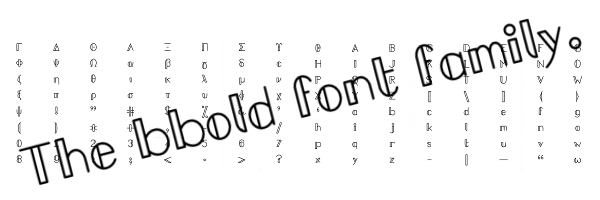Remembering all the mathematical symbols and operations can be difficult, especially when they double.
At OMC, we created a fundamental Math Symbols and Their Meanings series to help you memorize the symbols.
Or if not, at least you can return anytime to our blog and check the meaning of the symbols right away.
Blackboard Bold or Doublestrike
You might have seen double-stroke letters in mathematical questions. Blackboard bold letters are letters of the alphabet written with double vertical strokes indicating sets. They used to be called “blackboard bold” because the only way to signal them on the blackboard was to add another stroke.
Let’s Check The Most Common Sets That Are Indicated By Blackboard Bold Letters
“𝔸”
A double-stroked, capitalized letter “A” denotes an algebraic set. An algebraic set defines a set of zeros in a collection of sums of powers in variables multiplied by coefficients (algebraic sets are used in geometry in order to define curves and their dimensions). It is a set of algebraic numbers.
“𝔹”
It indicates a set of “true” and “false” elements. Given X ∈ Booleans, x is clearly defined as True or False.
“ℂ”
It indicates the set of complex numbers. Complex numbers have the form of two real numbers and an imaginary number, such as “2+3i”. An imaginary number is indicated by the letter “i”, i = -1.
“𝔻”
It generally indicates the opening of a two-dimensional surface, in geometry. But it can also refer to decimal fractions or split-complex numbers.
“𝔼”
It is mainly used to indicate the Euclidean space or the Eudoxus reals.
“𝔽”
As you might have expected, this symbol represents fields. A field is a set of two or more elements, where addition and multiplication are defined so that for each pair of elements there are unique elements following the same conditions for all elements.
“𝔾”
It indicates a set of complex numbers where the two numbers are integers, also known as “Gaussian integers”.
“ℍ”
This symbol is used in spatial mathematics to define a hyperbolic space or an extension of complex numbers, known as a quaternion.
“𝕀”
It indicates an integer number. An integer is a number that has no decimal or fractional part. Some examples: -1, 0, 1, 5, – 7, 6, 8, …, ∞
“ℕ”
This symbol indicates a natural number. A natural number is a positive integer.
“𝕆”
It defines the set of octonion numbers; these numbers are used in quantum logic or special relativity.
“ℙ”
It refers simply to primes. A prime number is a positive integer number greater than 1 and can be divided only to 1 and the number itself.
“ℚ”
This symbol is pretty common and you might already recognize it as the set of rational numbers. A rational number represents the ratio between two integer numbers.
“ℝ”
As familiar as the symbol above, this one indicates the set of real numbers. The real set of numbers comprises all the rational and irrational numbers, which can also be indicated by “c” from the word “continuum”.
“ℤ”
Last, but not least, this symbol indicates the set of integers. You can also encounter it under the following forms: “ℤn” meaning the set of integers of modulo n, “ℤ–” denoted negative integers, and “ℤ+” indicated positive integers.
Other blackboard bold symbols can be used in spatial mathematics and in geometry but they follow more complex theorems and are not included in a middle or high school curriculum.
However, mathematical language has already been inputted in computer symbols, known as Unicode, so math enthusiasts can easily take on the online practice.

Miscellaneous Definitions
Integers modulo n, also known as modular algebra, defines an equivalence relation “modulo n”. A and B are two integer numbers that must have the same remainder when divided by n.
Example: Is the following statement true or false?
3 ≡ 18 mod 4
Tip: Can 3 and 18 be divided by the same number in order to obtain an integer?
Polynomial
A mathematical expression consisting of operations (addition, subtraction, multiplication) with variables, constants, or exponents.
Example: x3- 2x = 0
Matrix
A rectangular array of numbers, symbols, or expressions, arranged in rows and columns. Matrices can also be added, subtracted, divided, or multiplied. The columns and rows are aligned between the following brackets: “[ ]”
Example: a = [ -2 0 2 1
-6 3 4 8]
Euclidean Space
Sometimes called the “Cartesian space”( n-space), it is the space of all vectors (n-tuples), in a two or three-dimensional space. It originated in Euclidean geometry, the study of plane and solid figures on the basis of axioms and theorems, created by the Greek mathematician, Euclid, approximately 2000 years ago.
At the Online Math Center…
We make sure that our students grasp the basic concepts of mathematical language so that they can expand their knowledge.
We offer math tutoring for middle to high school students, as well as preparations for competitions.
Contact us anytime for more details on our math tutoring programs!